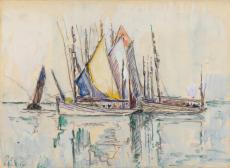


It seems that it was Camille Pissarro (1830-1903) who suggested to Paul Signac that he turn to watercolour in 1888. The first known attempts carried out by the painter in this technique date from his installation in the Midi, in Saint-Tropez, in 1892, relatively late in his career. Yet, very soon, and despite his initial concern, Signac perfectly mastered the effects of this medium. His first watercolours, reworked by vigorous strokes of the pen, are redolent of the graphic art of Vincent van Gogh (1853-1890), whom he knew well and admired. Little by little, these heavily applied lines were transformed into a supple network of strokes with a soft pencil in velvet black or graphite, which become increasingly lighter, supporting and organising the large brushstrokes of colour. Signac soon defined himself as an aquarelliste-trotter (a trotting watercolourist) and exhibited his ‘watercolour notations’ beside his oil paintings as an integral part of his creative process. Gradually, his watercolours grew in size and became fully fledged artworks; after 1920, they came to occupy a prominent place in the artist’s output.
Bateaux à Groix, dated to 1923, is typical of the prolific, brilliant work of the end of Signac’s career. The sailboats have been rapidly drawn, but with keen attention to the details of the rigging or the special equipment, outlined with a soft pencil; firm hatching lines define the planes of the sails and the reflections on the calm sea, the colour being distributed freely, though with a certain frugality, which conveys to the ensemble lightness and transparency. In 1923, Signac stayed in the Breton port of Groix, famous for its tuna boats, which the painter sought to describe, well aware that these boats with their traditional riggings could not survive the momentum of progress. A sailor himself since his youth, Signac was at ease on the docks with his notepad in hand. He soon described his enthusiasm in a letter, dated 13 July 1923, to his old friend, the art critic Félix Fénéon (the same one who coined the sobriquet ‘Neo-Impressionism’): ‘It was marvellous at Groix, the preparation and the departure of the tuna boats. I was like a crazy kid, on the lookout at the end of the pier, from morning till night. But with the evenings came the backlash – I no longer had the strength to open my mouth to eat. It was a rough hunt, but I have many trophies.’1 Besides these watercolours, Signac actually devoted numerous canvases to this theme, to which he returned in the years that followed. Signac’s enthusiasm for this subject gave rise, a few years later, in 1929, to the famous series of 100 French ports, which he undertook with the support of one of his most fervent admirers, Gaston Lévy (1893-1977). In his own way, Signac also hoped to repeat, in the 20th century, the commissioning by Louis XV of the painter Claude-Joseph Vernet (1714- 1789) to paint a series of French ports. Even though, today, it is the colourful, dynamic and masterful vision of the painter that is of prime importance in our appreciation of these watercolours, their documentary interest, following the destruction caused by World War II, is not to be overlooked in the evocation of a vanished world.
He was training as an architect, but when he attended an exhibition of works by Claude Monet he decided on a career in painting. Together with fellow Neo-Impressionist Georges Seurat, he developed the Divisionist technique, which confers a sparkling luminosity to the canvas by juxtaposing pure colour applied in small points. He travelled extensively, painting mostly landscapes and seascapes. He also mastered watercolour, which came to occupy a prominent place in his oeuvre. He was president of the Société des Artistes Indépendants from 1908 until his death and encouraged many younger artists; he was the first to buy a painting by Henri Matisse.